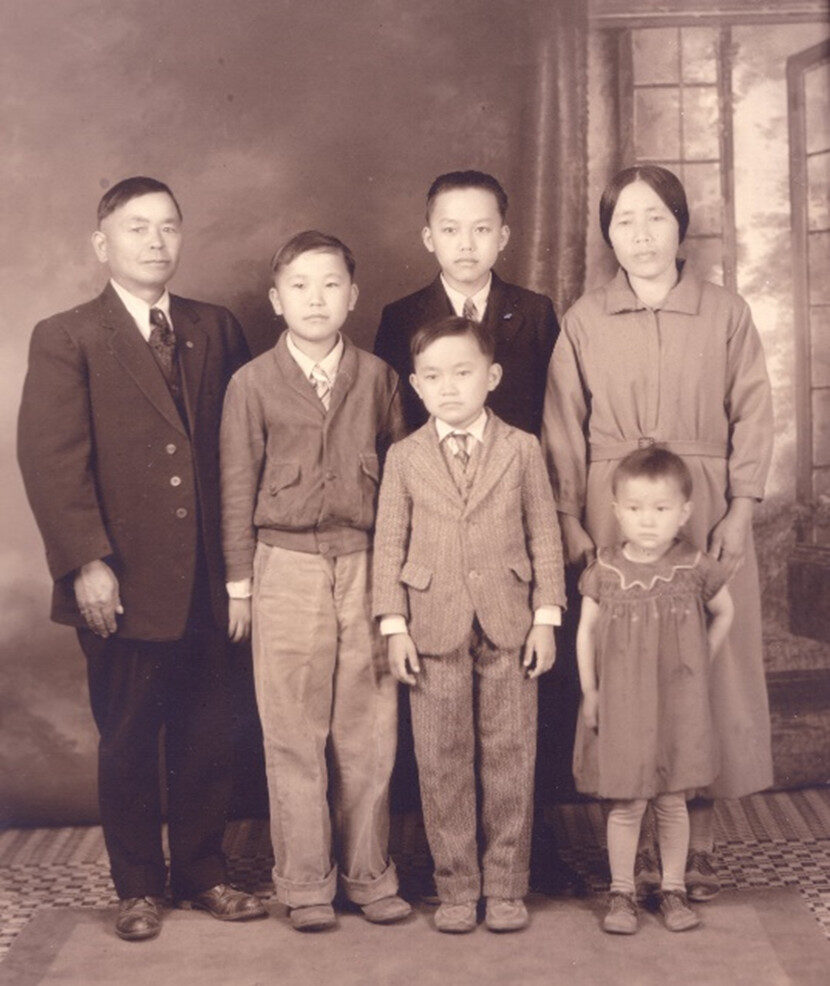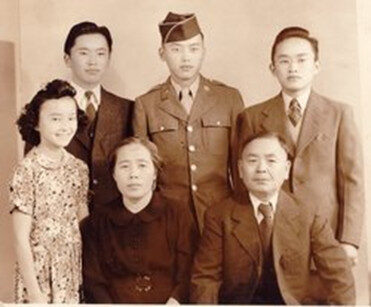Soldier Story: Mamoru Kinoshita
Soldier Story

Mamoru Kinoshita
Private First Class
442nd Regimental Combat Team
3rd Battalion, Headquarters Company
Mamoru Kinoshita was born on January 13, 1923, in Stockton, California, to Ichijiro and Moto (Nakashima) Kinoshita. He had two younger brothers – Yutaka and Leonard, and a younger sister – Betty Lucille. His father, Ichijiro, first arrived in 1903 and worked as a farm hand in Northern California before returning to Japan. In 1906, he left Japan for Honolulu where he worked as a field laborer. He returned a second time to Japan and then emigrated to Seattle, Washington, arriving on the Suwa Maru on August 27, 1918. From Seattle, Ichijiro settled in the area of Stockton, California, to engage in farming.
Mamoru attended Winton Grammar School and graduated from Livingston High School in 1942 in Livingston, California. He was strong academically in language and history and looked forward to a career involving social sciences. Mamoru was a member of the Boy Scouts and also enjoyed manual arts creativity.

Right: About 1930; L to R – Father Ichijiro, Leonard, Mamoru, Mother Moto; front row – Yutaka and Betty
The Kinoshita family was evacuated to the WCCA (Wartime Civil Control Administration) Assembly Center at the Merced County Fairgrounds in May 1942. While there, Mamoru was employed by the Center and he registered for the draft on June 30, Local Board No. 115. His draft card listed him as 5’7½” tall and 132 pounds, and his father was his point of contact. On September 18, the family was incarcerated at Granada (also known as Amache) WRA Center in southeast Colorado. Mamoru was released on October 21, 1942, to nearby Bristol, Colorado, for employment. He then moved to Brighton, near Denver, where he worked on the farm of a Mr. Nelson. The rest of his family remained at Granada until released in June, September, and October 1945.
Mamoru Kinoshita enlisted in the U.S. Army on May 12, 1944, at Camp Upton, in Yaphank, Sussex County (Long Island), New York.

Left: Kinoshita family, 1944
“Mummy,” as Mamoru was known, was sent to Camp Shelby, Mississippi, for training for the 442nd Regimental Combat Team. He was then sent to the Theater of Operations as a replacement assigned to 3rd Battalion, Headquarters Company.
Kinoshita arrived in France when the 442nd was just preparing to depart from the Rhineland-Vosges Campaign. He was among the 382 replacements who arrived in the Vosges on November 18, 1944. The Combat Team was at about half-strength after a large number of casualties in the preceding month of fierce fighting.
The 442nd left the Vosges by trucks and headed south to Nice. Over the next few months, their mission was to protect the right flank of the 6th Army Group and guard against a possible enemy attack and breakthrough in southeastern France by the German Army in Italy. This was the Rhineland-Maritime Alps campaign. The 442nd sent combat and reconnaissance patrols back and forth between the lines, sometimes making enemy contacts and trying to avoid the many mines that had been laid by earlier units who left no record of their location. Third Battalion alternated between the areas of Sospel and L’Escarène high up in the mountains. There were frequent day-passes to Nice on the coast, where the men enjoyed the night spots with music, dancing, and Army rest centers in Nice and Cannes. For this reason, this period was nicknamed the “Champagne Campaign.”
During the months in southeastern France, the 442nd received many of its wounded back to their companies and their troop strength meant they were again able to return to offensive combat. On March 17-19, 1945, the units were moved to a staging area at Marseille, followed by transfer in ships to Italy on March 20-21.
They arrived at the Peninsular Base Section in Pisa on March 25 and were assigned to Fifth Army for the Po Valley Campaign. Their objective was to execute a surprise diversionary attack on the western anchor of the German Gothic Line. This elaborate system of fortifications had been attacked in the fall of 1944, but no one had yet been able to pry the Germans loose from the western end. The Gothic Line in this area was hewn out of solid rock, reinforced with concrete, and constructed to give all-around protection and observation. The Germans were dug into mountain peaks rising almost sheer from the coastal plain, bare of vegetation save for scanty scrub growth.
The Combat Team left their staging area and moved to a bivouac at San Martino, near the walled city of Lucca. New replacements who had seen little or no combat practiced small-unit problems with their squads and platoons far into the night. Starting on April 3, the 442nd pushed the Germans north from Mount Folgorito, and on to Montignoso, Massa, across the Frigido River, Carrara, and Mount Pizzacuto.
On April 20, the Combat Team was in the vicinity of Fosdinovo and Mt. Nebbione, which the Germans were fiercely defending. Third Battalion was probing the enemy defenses on Mt. Nebbione from every possible angle, but were consistently beaten back. The men were weary after climbing up and down 3,000-foot peaks for two weeks without much rest.
The following day, April 21, the battalion continued the attack. That night the I Company Command Post (CP) took a direct artillery hit and Corporal Mamoru Kinoshita, who was at the CP at the time, was hit in the thigh and killed. According to the men of I Company, the word was that it may have been friendly fire from a shore battery or it may have been a booby trap set in the cave.
Pfc. Shuji Taketomo later wrote about this incident:
During the day … the meadow next to the I Company location was being shelled. Acting Company Commander 1st Lt. [James] Wheatley organized the command post near a shale mine entrance that afternoon,….about 9:30 p.m.….there was a big swoosh followed by an explosion. The blast was so great that I was tossed into the air, landing a few feet away from where I had been awaiting my turn to go on guard duty.
On Taketomo’s accompanying map he noted that the meadow was about eight acres in size with no trees or bushes, only short grass as ground cover. He noted the location of the command post in relation to the placement of the artillery fire and concluded, “Perhaps that may shed some light upon this incident.”
Sgt. Richard Shinto later wrote about this night:
…I Company under Lt. James Wheatley was waiting for an outfit to relieve us. Approximately seventeen of us were waiting in the opening of a mineshaft. It was stuffy and crowded, so I went out for some fresh air. The mine shaft opening took a direct hit; seven to eight men were killed. We lost a lot of good comrades that day.
T/Sgt. Jim J. Yamashita, later wrote to Mamoru’s brother Leonard:
I was on line when I Company’s CP (Command Post) was shelled. To this day we are not sure whether it was a short round of artillery shell, mortar, or even shell from naval ships in the Leghorn Harbor. Whatever it was, it was devastating and damage was compounded by the confined area of a mine shaft. Your brother, Mamoru, was with 3rd Battalion Headquarters Company but was attached to I Company as a communication detail . . . Even though I was never acquainted with your brother, I had the unpleasant task of supervising the removal of the bodies the next morning after the shelling. Besides your brother there were four others, including a Caucasian officer [1st Lt. Wheatley] who died. There were a number of wounded that were evacuated that night. I remember it was getting dark when the CP got hit, and there was chaos as we had just moved into that position. What I remember about the removal detail was that several Italians came up with mules. After giving them instructions and seeing their bodies, I recall getting sick to my stomach and had to sit down on a bank while the Italians would come to me for further instructions. I usually don’t go into this much detail, but this is the first time I am able to talk to the next of kin of someone who died in the incident. It is with this passion that we are endeavoring to preserve the memories of those who died…
Pfc. Mamoru Kinoshita was buried at the U.S. Military Cemetery at Granaglione, Italy, in Plot D, Row 12, No. 576.
For his military service, Private First Class Mamoru Kinoshita was awarded the Bronze Star Medal, Purple Heart Medal, Good Conduct Medal, European-African-Middle Eastern Campaign Medal with two bronze stars, World War II Victory Medal, Distinguished Unit Badge, and Combat Infantryman Badge. He was posthumously awarded the Congressional Gold Medal on October 5, 2010, along with the other veterans of the 100th/442nd Regimental Combat Team. This is the highest Congressional Civilian Medal.
In 1948, the Army was closing the smaller cemeteries in Italy and families were given the choice of having their loved one moved to the large cemetery in Florence or returned home. The Kinoshita family chose to have Mamoru brought home. After his return, his graveside service was conducted by a Protestant chaplain at 3:15 p.m. on December 3, 1948, at the Golden Gate National Cemetery, San Bruno, California, in Section C, Site 482-A.
Researched and written by the Sons & Daughters of the 442nd Regimental Combat Team in 2021.